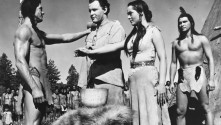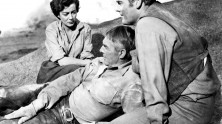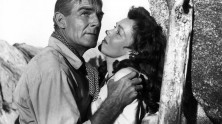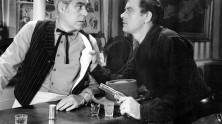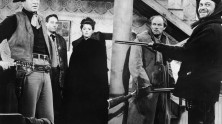
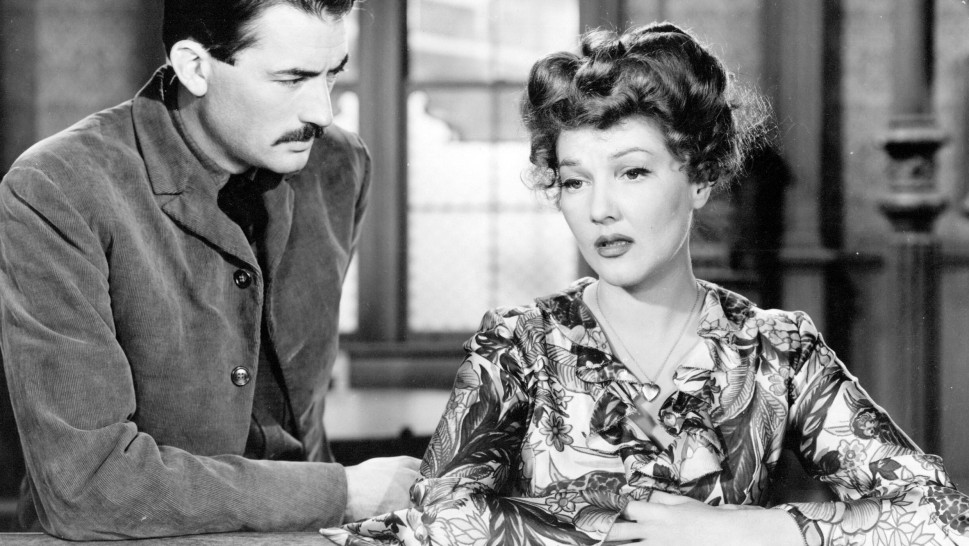


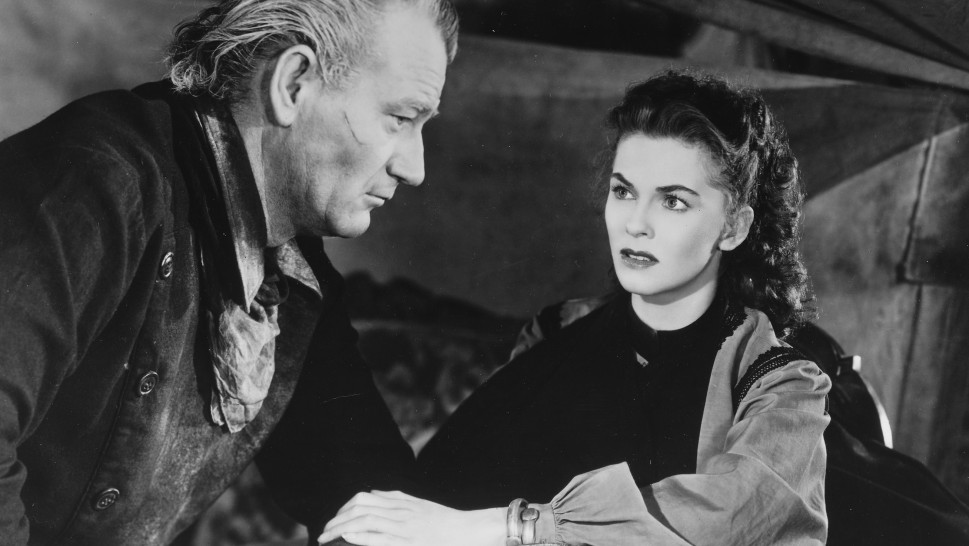
Fortunes of the Western
Boredom and good fate may have caused travelers to thumb through the December 2013 issue of Magazine, the glossy monthly Air France stuffs in its seatback pouches to hawk duty-free perfume and canned caviar. They might have happened upon an article advertising another French commodity: the classical American Western. A brief interview that well-named Marie Aucouturier led with filmmaker and critic Bertrand Tavernier, frequent and welcome visitor to the Harvard Film Archive, informed readers of his undying love of the genre. So undying that in partnership with Actes Sud, currently France’s keenest publisher of creative and critical writing, he is reissuing a series of Western novels of bygone times under the title “L’Ouest, c’est vrai” [“The West, It’s True”]. Inspiring many feature films in the halcyon days of the studio era, sadly, few of the original novels can be found in Harvard’s Widener Library. It can be wagered that despite their elegant design and crisp translation these new editions will never make their way to our shores. Whether they do or not is less significant than what Tavernier’s project makes clear: that much of the American Western owes the recovery of its genius to what Gallic cinephiles have done with it.
As if he had been planning the current retrospective, Tavernier’s words tell us why. He corrects his interviewer in noting that the Western is hardly about cowboys and Indians. It is in fact “an immense genre that addresses everything: the conquest of America, the founding of law, racism, anti-racism…It even frays into film noir and be steeped in neurosis. Look at films like 3:10 to Yuma, The Hanging Tree, She Wore a Yellow Ribbon or My Darling Clementine, and you’ll wonder who are the heroes and who are the villains. And in The Searchers the hero is one of the darkest characters in the history of American cinema, played no less by John Wayne!”
Tavernier adds three critical points that might inflect the viewings of the weeks ahead. First, and always tricky, the relation between the western novels (by Peter Field, W. O. Burnett and others far below the radar of those who think of Zane Gray) and their adaptations is a matter more of betrayal than translation. Like today’s impatient filmmakers who “can’t read their way out of a paper bag,” many directors of the post-war years preferred shooting film to carefully reading and adapting the novels for their storyboards. Such was Roy Rowland’s Bugles in the Afternoon (1952), a feature showing that the director and screenwriters (Daniel Mainwaring and Harry Brown) never paused to look closely at the writing of Ernest Haycox, prolific writer and also author of a story called “Stage to Lordsburg,” the toponym immediately recalling obese Andy Devine’s delightfully crackly voice when he puts the whip to the horses of Stagecoach (1939). Now reissued in French, Haycox’s novel does what Rowland’s film did not. “The tone is broad and epic, nature plays immensely on the characters’ destiny. We’re in the great tradition of Jack London. Daily life at the outpost is told in minute detail, and then we witness one of the greatest disasters in the history of the American Cavalry. Usually this disaster is magnified while here the approach is much darker and far more complex. It brings forward a multitude of contradictory viewpoints, and is extremely original.” By strong contrast to Rowland, adds Tavernier, Henry King, director of three taut masterpieces – Jesse James (1939), The Gunfighter (1950, which counts among the features in our retrospective) and the oft-overlooked Bravados (1958) – made meticulous use of the material with which he shaped his features. Gregory Peck once told Tavernier that in preparing his tale of Jimmy Ringo, when staging his existential masterpiece of 1950 King had studied more than 1500 photos from the late Western era in order to attend to details of clothing, gesture, stature, domestic architecture, even the consistency of mud.
Second, and not in the order of the interview, qualifying Aucouturier’s observation that the western is “making a comeback” in films by Eastwood, Tarentino, the Coen Brothers, the Deadwood series, and Ang Lee (whose overlooked Ride with the Devil he calls the “best I’ve seen on the Civil War”), Tavernier terms the western flageolant. It’s “wobbly”. Italian sequels to Sergio Leone decimated the genre when, one upon the other, in scenarios increasingly far-fetched and sensational, films were “shot often with abominable actors and horribly dubbed.” It may be that (the point not Tavernier’s but closer to ours in this retrospective), combined with the ambiance of the post-war years, the strictures of the studio system made for many masterpieces. In this state of things André Gide’s prescient words of 1899 still hold true: l’art naît de contrainte et meurt de liberté [art is born of constraint and dies of liberty]. Such is what viewers will remark about the spare and terse style of these so-called “minor” western directors in the program, some of whose names may not ring a bell: Budd Boetticher, Delmer Daves, Allen Dwan, Howard Hawks, Rudolph Maté, Phil Karlson, André de Toth, King Vidor, William Wyler.
Now, third, it may be that the Western wobbles because we no longer heed what Tavernier calls the art of filming space. Four (typically French) exceptions tell us that by and large today’s cinematographers haven’t really studied the Western. Two by Tavernier (It Begins Today and The Princess of Montpensier) and two by Bruno Dumont (Humanity and The Life of Jesus) aim the camera skyward, recording immense volumes of atmosphere that weigh on the terrain beneath, close to the lower edge of the frame, where humans move in trains or carriages or on horseback. “There’s always a space to film, and there’re always people to put into that space. (…) I’ve often been shocked by platitude of French historical films in their filming of space, nature…forests. Yet the Western and its great masters thought a great deal about space, seeing how characters were rooted their surroundings (…), whether a city, the inside of a ranch, a rocky landscape (…), the importance of hillsides, rivers, skies, characters bound to the landscapes suggesting that they are indeed the world in which they live." Hence the title of the interview, Filmer le ciel/Filming the Skies, offers another clue about the today’s wavering Westerns. Can a camera in the environs of Lone Pine follow characters riding over arid terrains in front of the jagged edges of the Sierras beyond that bite into the empyrean? Can they make the open spaces reduce characters to minuscule shapes in endless landscapes? The answer is no (1) because existential space may be of another age or (2) because, unless Photoshop or Final Cut Pro comes to the rescue, striations of contrails and congested air traffic proscribe filming of an unfettered sky.
Tavernier adds that he discovered the Western, notably Bugles in the Afternoon, in his childhood years when he and his father went to the movies together. Marxist Jacques Rancière relates that in his adolescence an untold erotic charge came at his sight of Colorado (Virginia Mayo), the half-breed beauty scampering after her ill-fated lover Wes McQueen (Joel McCrea) in the unforgiving landscape of Colorado Territory. The moment caused him, before he returned to his senses, to forget class struggle and the gridlock of capital, or even, however fleetingly the very industry that afforded the bliss. Likewise, viewers of this retrospective who are “of a certain age” will probably retrieve fleeting images embedded in childhood memories of the movies. When, as Manohla Dargis recently related in The New York Times (1/12/13), wondering what is happening when a surfeit of mainstream and independent features is made available for viewing anytime, anywhere, and in any form, how do they replace the theatrical experience that the seventh art had offered for viewers who “went to the movies” (like us, we the public assembled in the HFA) to see Westerns projected on big screens? Made palpable by virtue of carbon-arc projectors running 35mm prints through their gates, the great sky and space of the genre cast children of the postwar years in the enthusing and unsettling bind of Pascal’s “two infinities” a cosmic non-place which, in the Western spaces before our eyes, we suddenly felt, then as we do now, frail, insignificant and for that reason, within the confines of the movie theater, fortuitously present to ourselves.
As Tavernier and Rancière have done, we can let our earliest Western memories seep through the viewings of the features in the weeks before us. This person recalls that the first Western he saw in a theater, alone, at age six, Winchester 73, required upon his return home in the late afternoon an oral report to be delivered to his cinephilic father who had bestowed upon him a quarter for admission to the matinée, plus a nickel to buy a box of Mason’s Black Crows. Too small to sit in the unfolded seat, I perched myself on its upper edge and witnessed – the memories are limpid – the battle of the men, whom I now know as Will McAdam (James Stewart) and Dutch Henry Brown (Steve McNally), blasting at each other with carbines in the midst of grainy rock. Gunshots echoed while a soft wind blew amidst the granite crags of the mountain. Thirty years later American critics told me how, based on the Sophoclean tragedy, Anthony Mann’s tale of enemy brothers proves that the post-war Western is something greater than a simple shoot-em-up. Ten years after that some snobbish intelligentsia of Lacanian extraction condescended to inform me that the film illustrated the concept of “the signification of the phallus” because the ’73 Winchester, a lever-action repeater (thee pious viewers couldn’t distinguish a bolt-action from a pump-gun), circulating among men who wanted to have it in their hands, was an objet-petit-a (why not, I whispered under my breath, get off your high horse and call it an appetite-object?) attesting to the inviolable law of castration. A decade after that Gilles Deleuze informed me that the film embodied (contrary to its counterpart, the “interstice” of the time-image), the Bergsonian concept of the interval, no doubt (Deleuze never elaborates) because evil Dutch Henry, high on the mountainside, hears McAdam below, who yells to remind him of the lesson of thrift their father had taught them when they were children. Dutch needs time to reload: hence the advent of the interval, the gap, which in this instance spells the villain’s demise. With all respect – due or not I don’t know – to the wisdom of Greek myth, the Lacanian phallus and the Bergsonian interval, every time I see Winchester ‘73 I tend to recall the delight of the first matinee on a Saturday afternoon in the summer of 1950.
By the time Winchester ’73 had come to France Paris was already the place, nec plus ultra, to see Westerns. No doubt because American export policies imposed its commodities upon the nation its armed forces had purportedly liberated, France was being bombarded with movies. Weaned on American celluloid, the enfants terribles who morphed into filmmakers of the New Wave counted among the most adept followers of the Western. Turning it from entertainment into an array of critical objects, without saying so they made its genre the equal of its auteurs. They fashioned repertories, engaged close readings, compared its signatures, returned to its sources and in the end wrote appreciations that are now an enduring hallmark. Such is Le Western: Approches, mythologies, auteurs-acteurs, filmographies [The Western: Approaches, Mythologies, Author-Actors, Filmographies] a multi-authored volume, dating to 1966, that Marxist publisher Christian Bourgois launched in cheap format, that Raymond Bellour (another friend of the HFA), in 1994 revised for publication by Éditions Gallimard. Written by twenty contributors, its entries are signed by then famous or emerging critics (Bellour, Jean-Louis Bory, Bernard Dort, Bernard Eisenschitz, Roger Tailleur, etc.), a future nouveau philosophe (André Glucksmann), other major filmmakers or artists (Robert Lapoujade, Tavernier himself), a great historian and theorist (Jean Mitry), a new novelist (Claude Ollier), and even, of a gender who brought fear to the men who were the architects of the New Wave, a woman (Monique Vernhes). Listing 599 films (yet in a Freudian slip omitting Stagecoach), elaborating on 58 auteurs or directors and 23 acteurs (nary a female), most of which are from the post-war era, the book presents a gazetteer of 57 “mythologies” (in line with Roland Barthes’ work under the same title) that are really topoi or topical places whose assemblage comprises a geography of the genre. Beginning with Alcoolique (Alcoholic – with words on Doc Holliday of My Darling Clementine), the list ends with Viol (Rape – an entry uncovering the traumatic underbelly of The Bravados and Rancho Notorious). In what amounts to deconstruction these “common places” offer a means of reading the Westerns transversally, diacritically, and thus spatially, with and against the grain of the narratives. For the authors these plot-points become points of reference for the mapping of the “auteurs” whose signatures are drawn in places that include Fistfights, Barbershops, Campfires, Sheriff’s Offices, Jails, and so on, and last but least, Woman (qualified as “theogony”). In addition to terse analyses the very selection of the places betrays the nature and the moment of the collective appreciation. Given what it does and how it works Le Western remains a viable user’s guide for crisscrossed readings of the seventeen films comprising the retrospective.
If Godard is correct in asserting that the histories of cinema that we fashion for ourselves are based less on narratives than indelible images or sequences with which we live our lives, many inhere in what might appear to be forgettable fare. The credits of The Gunfighter are set over a sequence of a solitary rider going who knows where on an infinitely rolling plain of sand and shrub under a darkened sky. In the style of a classical silent film (not a bar of music can be heard), in the sequences set in the town crisp pans follow characters going about their daily business all the while an atmosphere of vindictive menace prevails. At the beginning of Seven Men from Now rain pours uncannily in a dark night when, emerging from nowhere, Ben Stride (Randolph Scott) shares a cup of coffee (“much obliged”) with two men who cower by a campfire under an outcropping. Suddenly two horses are shown shocked at the sound of two gunshots. A close up of the icy face of Tex (Jack Lambert), frozen to death at the end of Day of the Outlaw, chills the happy end that follows. At the beginning of Jubal (in French as L’Homme de nulle part, or The Man from Nowhere), tumbling down a hillside, what seems to be a ball of detritus becomes the human form of hero Jubal Troop (Glenn Ford). Visual memory of two victims of random homicide, a boy and an elder tossed down a well come forward lugubriously in The Tall T when Pat Brennan (Randolph Scott) forced to dress a deer carcass, cuts through the hind quarters hanging from a makeshift gibbet. In The Violent Men the map that burns in the fire that Martha (Barbara Stanwyck), malevolent and bitchy spouse of crippled cattle baron Lew Wilkinson (Edward G. Robinson) set to an elegant home collapsing in view of the vast spaces outside. Next to angelic Sally Maris (Joan Leslie), Kate Quantrill (Audrey Totter), hard-ass wench of ill repute and “dark mirror” to her counterpart, becomes the force of attraction in Woman They Almost Lynched. When, at the climax of Terror in a Texas Town George Hansen (Sterling Hayden) confronts his enemy with a harpoon in place of six-gun our recall of thousands of iterations of “the gunfight” flash before our eyes. In Red River, in harmony with Dmitri Tiomken’s epic refrains, unforgettable lap-dissolves superimpose the cursive of a daily journal over great vistas, each a serial punctuation anticipating the confrontation of Tom Dunson (John Wayne) and Matt Garth (Montgomery Clift) that Tess Millay (Joanne Dru) resolves. These other sequences and many others belong to our vivid memories of Westerns on which, finally, no nation or person has purchase. The backbone of the genre in a span of some of its greatest years, seen anew and afresh, show us that, simply put, these films are what makes the Western what it is.
For this retrospective thus the rules of the game: a nod has not been given to Westerns that have already colonized our imagination, notably Destry Rides Again, Stagecoach, Rancho Notorious, The Searchers, Johnny Guitar and others. Conspicuously absent is John Ford, and so also Anthony Mann, past master of the post-war Western with Devil’s Doorway (1950), Winchester ’73 (1950), The Furies (1950), Bend of the River (1952), The Naked Spur (1953), The Far Country (1955), Man from Laramie (1955), The Last Frontier (1956), The Tin Star (1957), Man of the West (1958) and Cimarron (1960). And no less, Raoul Walsh, whose The Big Trail (1930), Wild Girl (1932), They Died with Their Boots On (1941), Pursued (1947) and Colorado Territory (1949) delighted viewers last spring. Have had to skirt the great silent films from Griffith to Ince and from William S. Hart to Ford and Fairbanks. Pioneers like Tom Mix remain for further study, and so also pre-war sound cinema, forcing exclusion of In Old Arizona, The Virginia Kid, and many others. Left in the margins, too, are the serials and great B-line Monogram films featuring Johnny Mack Brown and Raymond Hatton. And alas, many, many more. But for starters we proudly present a magnificent set of sixteen epic Westerns on a screen just grand enough to fit them all. – Tom Conley, Abbott Lawrence Lowell Professor, Departments of Romance Languages and Visual/Environmental Studies, Harvard University


